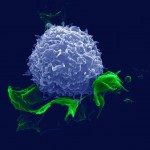Lien vers Pubmed [PMID] – 2828076
Eur. J. Clin. Invest. 1987 Dec;17(6):515-21
Anti-HBs monoclonal antibodies radioimmunoassay (m-RIA) and HBV-DNA hybridization techniques were used to detect HBs antigen (HBsAg)–associated determinants (evidence of HBV on-going infection) and HBV-DNA sequences (evidence of viral multiplication) in the serum samples of 479 patients who were HBsAg negative by standard solid-phase radioimmunoassay. They included 128 alcoholics, 104 patients with chronic hepatitis, fifty-four with an hepatocellular carcinoma, 100 with coagulation disorders and ninety-three blood donors. The aim of this study was the comparison in these populations of the prevalence of the various HBV markers. m-RIA detected HBsAg-associated determinants in 1% of blood donors, 3% of coagulation disorders, 3.1% of the alcoholics, 21.1% of chronic hepatitis and 16.6% of hepatocellular carcinoma; hybridization identified HBV-DNA sequences in 0.9%, 2.2%, 10.9%, 9.6% and 5.5% of these cases, respectively. The combined prevalence of both markers of an on-going HBV infection (with or without viral multiplication) was 14.16%, 26.9% and 22.2% in the latter groups, respectively, as compared with only 3% in patients with coagulation disorders and 2.1% of blood donors. These results confirm the frequency of HBV or HBV-related virus infection in alcoholics, in chronic hepatitis and hepatocellular carcinomas, despite the absence of HBsAg by standard RIA (or even of any other usual marker); this gives further evidence for variations in the expression of HBV infection. A high and quite similar prevalence of usual serum markers and hybridization results was observed in the alcoholics and in the patients with chronic hepatitis.(ABSTRACT TRUNCATED AT 250 WORDS)

